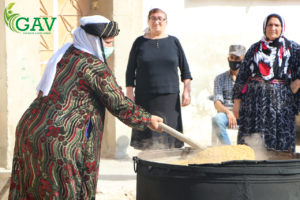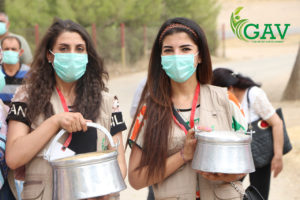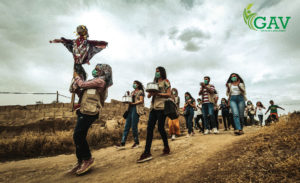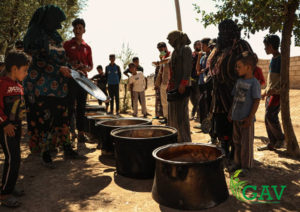Customs and common rituals decorate the lives of al-Jazira region such as (Danûk) and (Hano Qreitho)
A day after the participation of the volunteers and coordinators team of (Bayt al-Jazira – Mala Cizîrê – ܒܝܬܐ ܕܓܖܪܬܐ) project in the revival of (Hano Qreitho/ܚܐܢܐ ܩܪܝܬܐ) event in the village of (Moharkan) in the countryside of (al-Qahtaniyah/Terba Spiyeh/ܩܒܕܐ ܚܝܘܪܐ), the team concluded the week of the social events by preparing what is known as (al-Selija) in Arabic, (Danûk) in Kurdish, and (دانوكة / ܕܐܢܘܟܗ) in Syriac.
This ritual is considered one of the common customs among the communities of al-Jazira region (Kurds, Arabs, Syriacs and Yazidis), that is a kind of a celebration of wheat, which is one of the common symbols of the population of the region.
It started with preparing for the weekly live broadcast within the plan of the week of social events, by preparing the appropriate environment for the implementation of the activity, after selecting one of the popular alleys in the Salihiyah neighborhood in al-Hasakah, with the help of women from the four communities to talk about the common details of the rituals of preparing (al-Selija) in Arabic, (Danûk) in Kurdish, and (دانوكة / ܕܐܢܘܟܗ) in Syriac.
The week of social events is considered one of the most important aspects of the project (Bayt al-Jazira – Mala Cizîrê – ܒܝܬܐ ܕܓܖܪܬܐ), due to the importance of these events and the accompanying social rituals in strengthening the relations among the communities through identifying those rituals and the peculiarities of each community to build a common general culture based on the enrichment of the general knowledge of each community.
The closing ceremony of the week of social events was preceded by the participation of the volunteers and coordinators team of the organization in ceremonial rituals of (Hano Qreitho/ܚܐܢܐ ܩܪܝܬܐ), which is considered one of the oldest stories and myths in the Syriac history.
The team, along with the residents of the village of (Moharkan) in the countryside of (al-Qahtaniyah/Terba Spiyeh/ܩܒܕܐ ܚܝܘܪܐ), revived this celebration which falls on the last Sunday before the start of the Lent, as a celebration of the sacrifice of the daughter of one of the ancient kings of (Beth Nahrain).
The folk tradition of this celebration includes making a symbolic doll by the girls and taking turns carrying it and wandering around the residents’ houses to collect bulgur, eggs, ghee and meat, coinciding with singing special songs for the event, and then preparing traditional foods from the materials they obtained.
These two activities were part of the week of social events, which started last Monday with a visit to the village of (Qamar) in the countryside of al-Hasakah, which included the participation of the volunteers with the Yazidi residents of the village in the (kostek) rituals, that is common to most of the communities of al-Jazira.
The Yazidis celebrate this event, with the child’s first attempt to walk, as the two halluxes of the child are tied with a thin thread, then a bag of candy is put close to him to motivate him to walk towards it, then the turn of the rest of the children comes, as one of them takes the bag after cutting the thin thread, while the others chase after him to motivate the child to continue walking.
The week of social events also includes the participation of the volunteers’ team led by the coordinator Nazir al-Muhammad, in a traditional wedding ritual of the Arab community in the village of (Muaizileh) in the countryside of al-Hasakah.
The visit to the village of (Muaizileh) was preceded by the revival of (ليلة الحنّاء) in Arabic, (Êvara Hinê) in Kurdish, or(حينو – ܚܝܢܐ) in Syriac, for a Kurdish bride, as it is one of the most famous rituals before the wedding night, which is shared by the residents of al-Jazira region of the Kurds, Arabs, Syriacs and Yazidis.
The night starts with preparing a plate full of henna decorated with colorful ribbons and candles lit, then the bride who most often wears a traditional dress, sits and the girls around, and they start going around the bride in a festive atmosphere.
Then the girls start putting henna on the bride’s hand, and wrap her hands with a red fabric, after that the henna is put on the hands of the other girls.
The (Bayt al-Jazira – Mala Cizîrê – ܒܝܬܐ ܕܓܖܪܬܐ) project launched by the (GAV) organization at the beginning of last August, is an attempt to celebrate and promote cultural differences as a fundamental pillar in building and preserving civil peace and sustainable coexistence, and enhancing societal cohesion factors through deepening knowledge of the communities with each other and opening unconventional channels of communication among them.
Kurdî





